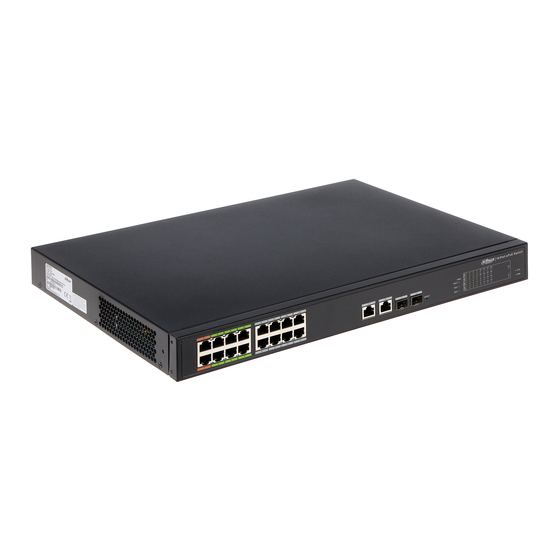
Table of Contents
Advertisement
Quick Links
Advertisement
Table of Contents

Summary of Contents for Dahua DH-LR2226-24ET-360
- Page 1 16/24-port ePoE Switch Quick Start Guide V1.0.1...
-
Page 2: Foreword
Foreword General This manual introduces the installation, functions and operations of the 16/24-port ePoE switch (hereinafter referred to as "the Device"). Read carefully before using the device, and keep the manual safe for future reference. Safety Instructions The following categorized signal words with defined meaning might appear in the manual. Signal Words Meaning Indicates a high potential hazard which, if not avoided, will result... - Page 3 the electronic version and the paper version. ● All designs and software are subject to change without prior written notice. Product updates might result in some differences appearing between the actual product and the manual. Please contact customer service for the latest program and supplementary documentation. ●...
-
Page 4: Important Safeguards And Warnings
Important Safeguards and Warnings This section introduces content covering the proper handling of the device, hazard prevention, and prevention of property damage. Read carefully before using the device, and comply with the guidelines when using it. Transportation Requirements Transport the device under allowed humidity and temperature conditions. Storage Requirements Store the device under allowed humidity and temperature conditions. - Page 5 Operation Requirements ● Do not disassemble the device without professional instruction. ● Operate the device within the rated range of power input and output. ● Make sure that the power supply is correct before use. ● Make sure the device is powered off before disassembling wires to avoid personal injury. ●...
-
Page 6: Table Of Contents
Table of Contents Foreword ........................................I Important Safeguards and Warnings ............................III 1 Overview ........................................1 1.1 Introduction ....................................1 1.2 Features ......................................1 2 Port and Indicator ....................................2 2.1 Front Panel ....................................2 2.2 Rear Panel ...................................... 3 3 Installation ....................................... 4 4 Wiring ......................................... -
Page 7: Overview
1 Overview 1.1 Introduction The Device is a layer-2 commercial switch. It provides a high-performance switching engine and large buffer memory to ensure smooth video stream transmission. With a full-metal design, the Device has great heat dissipation capabilities on its shell surface, and is able to work in environments that range from –10 °C to +55 °C (+14 °F to +131 °F). -
Page 8: Port And Indicator
2 Port and Indicator 2.1 Front Panel The following figure is for reference only, and might differ from the actual device. Figure 2-1 Front panel Table 2-1 Description of the front panel Name Description Supports 10/100 Mbps self-adaptation and ePoE long Ethernet port distance transmission. -
Page 9: Rear Panel
2.2 Rear Panel Figure 2-2 Rear panel Table 2-2 Description of the rear panel Name Description Power switch Powers on and off the Device. Power socket Supports 100–240 VAC. Ground terminal GND. -
Page 10: Installation
3 Installation The Device supports rack mount. Step 1 Attach the mounting bracket to the Device side panel (one on each side) and secure it with the screws provided with the rack. Figure 3-1 Install bracket Step 2 Attach the Device to the rack with screws. Figure 3-2 Install device... -
Page 11: Wiring
4 Wiring 4.1 Connecting GND Grounding the Device can protect it against lightning and interference. Step 1 Remove the ground screw from the Device and pass the ground screw through the round hole of the OT terminal of the ground cable. Turn the ground screw clockwise with a cross screwdriver to fasten the OT terminal of the ground cable. -
Page 12: Connecting Sfp Ethernet Port
The cable connection of RJ-45 connector conforms to the 568B standard (1-orange white, 2-orange, 3-green white, 4-blue, 5-blue white, 6-green, 7-brown white, 8-brown). Figure 4-3 Connect cable 4.4 Connecting SFP Ethernet Port ● When installing the SFP optical module, do not touch the gold finger of the SFP optical module. ●... -
Page 13: Connecting Poe Ethernet Port
4.5 Connecting PoE Ethernet Port If the terminal device has a PoE Ethernet port, you can directly connect this port to the Device PoE Ethernet port through the network cable to achieve synchronized network connection and power supply. The maximum distance between the Device and the terminal device is about 100 m. When connecting to a non-PoE device, the device needs to be used with an isolated power supply. -
Page 14: Quick Operation
5 Quick Operation 5.1 Login through Web You can log in to the Device through the web for management and operation. For details, see web operation manual. For first login, you need to change the password according to the on-screen prompt. Parameter Description IP address... -
Page 15: Appendix 1 Cybersecurity Recommendations
Appendix 1 Cybersecurity Recommendations Mandatory actions to be taken for basic device network security: 1. Use Strong Passwords Please refer to the following suggestions to set passwords: ● The length should not be less than 8 characters. ● Include at least two types of characters; character types include upper and lower case letters, numbers and symbols. - Page 16 reducing the risk of ARP spoofing. 8. Assign Accounts and Privileges Reasonably According to business and management requirements, reasonably add users and assign a minimum set of permissions to them. 9. Disable Unnecessary Services and Choose Secure Modes If not needed, it is recommended to turn off some services such as SNMP, SMTP, UPnP, etc., to reduce risks.
















Need help?
Do you have a question about the DH-LR2226-24ET-360 and is the answer not in the manual?
Questions and answers